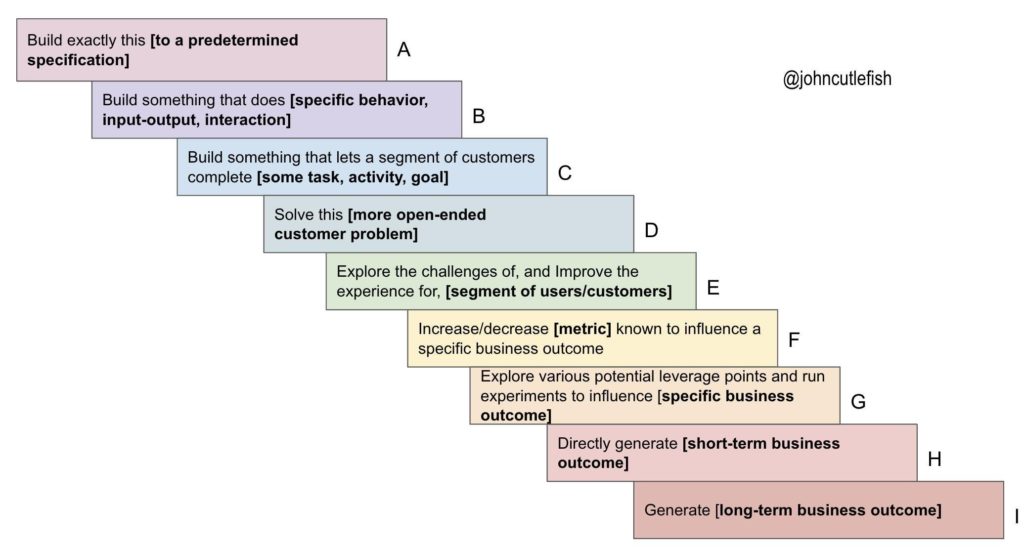Social and Organizational Psychologist Richard Hackman observed that one of the most crucial components necessary for enabling high performance in teams is that they have a compelling mission. Missions become compelling when they’re clear, coherent with the company vision, aligned throughout the company, and appealing to the team members. So if you’re aiming for empowered teams with high product autonomy (level E-I on the picture below), team missions (expressed through team mission statements) are an absolute necessity that will increase engagement, speed, and impact.
Ladder showing different levels of Product Autonomy, as described by John Cutler.
Sounds pretty straightforward, right? There’s one catch though: you need to make sure your team mission statements are properly defined or you will see conflict in your organization regarding the direction the teams should be heading in, your innovation will stall, and you’ll see low levels of engagement–and that’s just a few of the consequences of having poorly defined and expressed team missions.
If by now you are wondering what a team mission statement is, what it contains, and what makes for a good one, that’s great. That’s what I’ll discuss below. We’ll start by going through four common ways to express team mission statements and the pros and cons of each approach.
Grab a free copy of my case study: agile transformation at avanza here if you want to learn more about how missions play a crucial part in organizations that want to increase product autonomy, innovation, and engagement.
Four Ways To Express Team Mission Statements
In my work with teams, I’ve encountered four distinct ways of expressing team mission statements:
- Name mission statements
- Metric mission statements
- Customer Value mission statements
- A combination of the three.
First up we have Name mission statements. An example of a Name mission statement is “Music Player”, “Social”, or “Acquisition”. Name mission statements are short and to the point. If your product has clearly defined boundaries e.g. if you’re in a startup or you have a company that offers very distinct products, this might work really well. The Name mission statement acts as a context amplifier while leaving a lot of room for the mission to evolve.
The downside is of course that in most companies, product boundaries aren’t that clear. This creates a lot of ambiguity that can lead to potential conflict when different parts of the company rely on this team. What is in scope and what isn’t? What metrics are they optimizing for? And for what devices?
These are just some of the questions that Name missions don’t provide answers to. (Note: you can work around this by consciously choosing to include that information in your mission rather than keeping it out. But more on that later.)
Metric mission statements, on the other hand, have very clear goals. Examples include: “Decrease churn over time to 5%”, “increase the customer acquisition by 95000 users per month”, or “increase free to paying conversion with 7% month over month until it’s stable at 12%”. Sounds great, right? Unfortunately, that clarity can sometimes come at the expense of the employee and customer. When team members know what they’re supposed to achieve, it gives them a clear sense of focus. But if the goal is one-dimensional, the team might explore avenues of reaching that goal that appear to be good in the short term but have negative consequences in the long term. Additionally, it’s easy for teams to lose autonomy with Metric mission statements into if senior management hands out very exact metrics to hit that. If these metrics are only focused on the next quarter, strategy can take a hit which is, of course, bad in the long run.
Take for example the goal of decreasing churn by 5%. A team might be able to achieve that by lowering prices. But that, in turn, reduces revenue. Senior management might have thought that the team would achieve a 5% reduction through a better customer experience. Since that wasn’t made explicit, the team started exploring other ways of achieving that goal. Alternatively, they could choose to make it really difficult to unsubscribe. That would certainly reduce churn in the near term, but at the price of creating upset customers that do not return and that speak ill of your product.
Objectives and outcomes must be weighed and balanced, especially when it comes to Metric mission statements. When aiming for Metric mission statements it’s important to predetermine what time scale you want to focus on. A Metric mission statement focused on a 3-month period will sound very different from a 24-month long one. It’s usually good to try to add some checks and balances here by including at least one additional metric.
Customer Value mission statements are among the more popular ways of expressing team missions today. Examples are:
- “We create the best music listening experience for commuters”
- “We make it easy to discover new music that you love”
- “We create the safest investment experience out there so that our customers never have to second guess their investment decisions”
Customer Value mission statements express the experience and value you want the customer to have when using your product. Take the investment statement as an example. That’s about customers never second-guessing investment decisions. By knowing that, the team can start exploring what makes their customers second guess their investment decisions.
But why is not second-guessing decisions important? What happens if the team achieves this goal? How do they measure their progress? When is the team done? The Customer Value mission statement does not provide clear answers to these questions so further discussion within the team and with stakeholders is necessary. It’s important to answer the questions above early on so as to not leave lots of room for interpretation.
Combination mission statements, in my experience, have the most positive impact on alignment, teams, customers, and the company. Combination missions are missions that, you guessed it, combine elements of each of the mission statement types we covered above. While I’ve seen Customer Value missions work really well, if you can combine the three types, you can tap into all of their benefits. When you combine these approaches, you can often capture many of the upsides of all the different types of mission statements and less of the downsides.
But your company’s culture plays a big role here, so it’s important to take that into account when devising your missions. For example, Avanza is very dedicated to their customers and their needs, and they preferred to define missions that expressed the value their customers would get. In such a situation, evolving a Name mission statement (or no mission) into a Customer value mission statement is a huge improvement.
Team Mission Statement Examples
To help show you what I mean, I’ve created some team mission statement examples for you in the chart below. They’re also available in the exercise and facilitation guide that I’ve linked further down.
In the chart below, I’ve given examples of the same mission expressed in different ways. To help make this clear, I’ve highlighted the mission statement examples using different colors.
Different ways of expressing team mission statements.
Team Mission Statement Exercise
If you’d like to explore how different mission statement types can affect teams differently, here’s an exercise you can run. It takes about 90 minutes with groups of 15-30 people.
Instructions:
- Begin by explaining that there are four different ways to express missions. Explain how each type impacts alignment, autonomy, team member motivation, and a number of other factors differently.
- Next, share some (or all) of the examples shown above.
- Create groups of 3-4 members and hand out these instructions printed out on A3 paper.

- Ask the groups to have a look at the different ways of expressing team mission statements and then assess how they impact the factors listed on the evaluation page. I recommend that groups evaluate all the factors one column at a time. This part usually takes about 20-30 minutes.

- Once done, have all groups place their assessments on a wall so that you can see similarities and differences between different groups. Count the green, yellow, and red lights by type of mission to see which comes out on top.
- Groups that have a hard time assessing mission types usually find it easier to compare. Having a relative evaluation scale is a great tool for that. Consider using the following question: “Out of these four options, which option/s has the most positive and most negative impact?”
- From here you can take the exercise to a few different places:
- Ask people to reflect on how their missions currently are expressed and have them assess the impact that has
- Talk about how people would prefer their team mission statements to be expressed
- Examine how to move forward based on this
- Have them brainstorm, without making any decisions, what missions could sound like for them

Learning about Team Mission Statements vs discovering missions
The exercise above helps determine how to express your team mission statement, but that’s assuming you already have a sense of what it should be. Identifying potential missions is separate work that typically takes a longer time, from weeks to several months even. At Nordic Entertainment Group for example, we gathered a cross-departmental and cross-functional group for two days per week during a period of eight weeks to identify potential missions to organize teams around. It’s not an overnight process, but it yields great results.
Once you have a backlog with potential missions you could build teams around, deciding which ones to actually focus on is an investment decision. At this point, the company needs to decide which missions are best to spend time and effort on, i.e. which ones to invest in.
When an investment decision has been made, the product manager can continue to build a more compelling narrative around the mission statement.
Try it out if your teams purposes are unclear
If your teams purpose isn’t clearly defined, review this blogpost in your product management team and run the exercise. Just to see what you discover. And if you do, let me know in the comments below. I’d love to hear how it went for you.
-Viktor
P.S Redefining Mission Statements and agile transformations
If you’re looking for more ways to help your teams and your organizations, check out the free e-book I wrote about my time helping Avanza Bank through their agile transformation. Get your own copy below.




4 Comments
Kedir Geda
Great
Joseph Ochai
The blog was very educational and inspiring I will go through it over again
Ajay Sharma
Good experience
Ali Raza
Good experience 😊